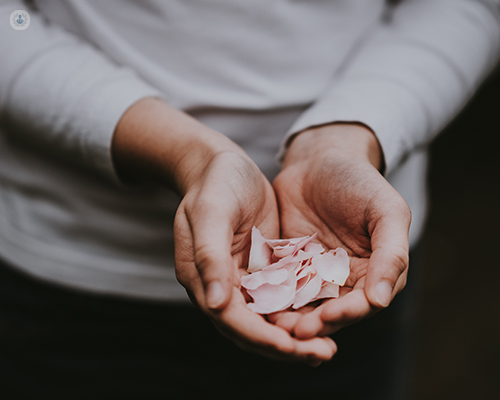Nerve injuries: what recovery should I expect?
Escrito por:Suffering from a nerve injury can leave people feeling fearful that their nerve function will never return. Renowned orthopaedic hand surgeon Mr Andrew Logan explains various types of nerve injury and what to expect while recovering from these injuries.

What nerve injuries are there?
There are several different types of nerve injury. The injury could be a clean cut, a crush or loss of a section of nerve. The recovery I am describing below is related to a nerve that has been cut cleanly; for example, from an accidental cut with a knife.
How does the anatomy of the nerve relate to a nerve injury?
The cross-section of a nerve has similarities to an electrical cable. There is an outer tube with a group of smaller tubes inside. Inside these smaller tubes, the axons run. The axons are the electrical wires of the nerve.
A cut to the nerve divides the tubes and the axons that they contain. Although such a nerve can be repaired, it is not possible to match up the tiny tubes within the nerve. The body helps to match growing nerve axons to the correct tube on the adjacent cut surface of the nerve using a chemical targeting process.
Not all growing axons will be able to find the correct tube or be able to find a tube at all. Axons that do not find a tube to grow down can thicken at the area of injury, forming a painful nerve ball (neuroma).
How long does it take for nerve function to return after an injury?
After an axon has been cut, the body removes that axon, leaving a hollow tube. The axon at the other end of the cut nerve then has to grow down the tube.
It takes around one month before the axon starts to regrow and then advances at approximately one mm per day, meaning that it takes around one month to grow three centimetres. As a result, the time it takes for the nerve function to return depends on the distance that the growing axon has to reach.
Will I get normal function after a nerve repair?
Unfortunately, this is not usually possible. Recovery is incomplete and for a sensory nerve, I would hope for a ‘protective’ sensation after recovery. This means that some sensation is felt but not enough to feel and manipulate small objects with the hand (e.g for nerve injuries that involve the thumb or index finger or middle finger).
With regards to a nerve that connects to muscle, I would expect some muscle function. However, it is most likely there will be some weakness in the muscle groups supplied by the injured nerve.
How can I best support my recovery from a nerve repair?
Sadly, most of the recovery process is out of your control. That being said, the majority of consultants will refer patients to hand therapy. They may make a splint to help protect the repair and begin range of movement exercises to allow the nerve to glide.
How can I reduce the risk of cutting a nerve?
To reduce the risk of cutting a nerve, you should always cut away from yourself when using a sharp blade, such as a blade from a knife, work cutting tool, crafting blade or scissors.
If you are suffering from a nerve injury and would like to discuss this with Mr Logan, simply visit his Top Doctors profile to bok a consultation today.


